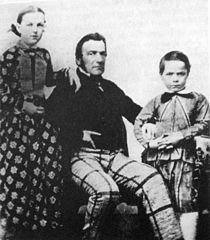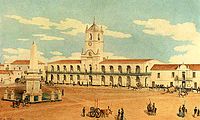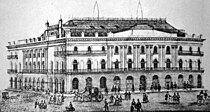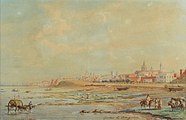Charles Pellegrini: Difference between revisions
Christian75 (talk | contribs) Clean up using AWB |
→Life and work: Fixed typo, the Pellegrini house Is still in Croglio. Tags: Mobile edit Mobile web edit |
||
| (32 intermediate revisions by 18 users not shown) | |||
| Line 1: | Line 1: | ||
{{short description|French Argentine engineer and artist}} |
|||
{{Infobox person |
{{Infobox person |
||
|name = Charles Pellegrini |
|name = Charles Pellegrini |
||
| Line 5: | Line 6: | ||
|caption = Charles Pellegrini with his eldest children,<br /> Julia and Carlos |
|caption = Charles Pellegrini with his eldest children,<br /> Julia and Carlos |
||
|birth_date = 28 July 1800 |
|birth_date = 28 July 1800 |
||
|birth_place = [[Chambéry]], |
|birth_place = [[Chambéry]], Savoy, present-day France |
||
|death_date = {{death date and age|1875|10|12|1800|7|28}} |
|death_date = {{death date and age|1875|10|12|1800|7|28|df=yes}} |
||
|death_place = [[Buenos Aires]] |
|death_place = [[Buenos Aires]] |
||
|nationality = |
|nationality = Italian and Argentine |
||
|signature = |
|signature = File:Carlos E Pellegrinni, firma.jpg |
||
}} |
}} |
||
'''Charles Henri Pellegrini''' (28 July 1800 |
'''Charles Henri Pellegrini''' (28 July 1800 – 12 October 1875) was an [[Italian Argentine]] engineer, lithographer, painter, and architect. |
||
==Life and work== |
==Life and work== |
||
Charles Henri Pellegrini was born in [[Chambéry]], [[Savoy|Savoie]] |
Charles Henri Pellegrini was born in [[Chambéry]], [[Savoy|Savoie]] in 1800 when the region was occupied by French revolutionary forces. His mother, Marguerite Berthet, was French, and his father, Bernardo Pellegrini, was a Swiss-Italian from [[Croglio]], [[Canton Ticino]], in the Italian-speaking part of Switzerland.<ref>{{cite web|url=http://www.swissinfo.ch/spa/index.html?cid=5338066|title=Carlos Pellegrini el 'suizo' que gobernó Argentina|publisher=Swiss Info|language=es}}</ref><ref name=alcurnia>{{cite web|url=http://www.genealogiafamiliar.net/getperson.php?personID=I21918&tree=BVCZ|title=Carlos Enrique Pellegrini Berthet|publisher=Genealogía Faniliar|language=es}}</ref> Pellegrini was a talented sketch artist at an early age, and his drawings earned a prize while he was still in primary school. He enrolled at the [[University of Turin]] and later at the [[École Polytechnique]], near Paris, where he earned an [[engineering degree]].<ref name=de>De la Croix-Riche Chanet, C.R. ''Franceses en el Río de la Plata y el Atlántico Sur, 1526-1876''. Buenos Aires: Megalibros Editores, 2004.</ref> |
||
Pellegrini was contracted as an engineer by [[Juan Larrea (politician)|Juan Larrea]], a prominent [[Spanish Argentine]] merchant with interest in [[Bordeaux]], by request of President [[Bernardino Rivadavia]], and he arrived in Buenos Aires in November 1828. He took a post in the [[Hydraulic Engineering]] Department. The bureau, however, was decommissioned in 1829 by order of the [[Governor of Buenos Aires]], General [[Juan José Viamonte]].<ref name=de/> |
Pellegrini was contracted as an engineer by [[Juan Larrea (politician)|Juan Larrea]], a prominent [[Spanish Argentine]] merchant with interest in [[Bordeaux]], by request of President [[Bernardino Rivadavia]], and he arrived in Buenos Aires in November 1828. He took a post in the [[Hydraulic Engineering]] Department. The bureau, however, was decommissioned in 1829 by order of the [[Governor of Buenos Aires]], General [[Juan José Viamonte]].<ref name=de/> |
||
He then returned to his early talent, |
He then returned to his early talent, drawing, and sold a number of [[watercolour]] paintings, notably cityscape impressions. He was hired by his fellow countryman, journalist and lithographer César Hipólito Bacle, in October 1830 as a [[portrait painter]], and by the end of his commission in September 1831, he had earned around 17,000 [[Argentine peso moneda corriente|pesos]] (around US$700). He continued to live as a successful lithographer and painter until 1837, when he purchased an [[estancia]], ''La Figura'', in [[Cañuelas]].<ref name=de/> |
||
He married María Bevans Bright in 1841, and the couple had four children.<ref name=alcurnia/> His wife was the daughter of [[Anglo Argentine]] engineer James Bevans, who had been Pellegrini's supervisor at the Hydraulic Engineering Department years earlier. That year, he and Luis Aldana founded the "Lithograph of the Arts," an [[Atelier (art)|atelier]] and [[printing house]]. He subsequently installed his own press at his [[San Nicolás, Buenos Aires|downtown]] Buenos Aires home, and remained mostly at ''La Figura''.<ref name=de/> |
He married María Bevans Bright in 1841, and the couple had four children.<ref name=alcurnia/> His wife was the daughter of [[Anglo Argentine]] engineer James "Santiago" Bevans, who had been Pellegrini's supervisor at the Hydraulic Engineering Department years earlier. That year, he and Luis Aldana founded the "Lithograph of the Arts," an [[Atelier (art)|atelier]] and [[printing house]]. He subsequently installed his own press at his [[San Nicolás, Buenos Aires|downtown]] Buenos Aires home, and remained mostly at ''La Figura''.<ref name=de/> |
||
Following the overthrow of Governor [[Juan Manuel de Rosas]] in 1852, Pellegrini returned to Buenos Aires, founded the ''Revista del Plata'' (1853), and received numerous contracts as an engineer and architect. The most notable of his works in this latter field was the Colón Theatre. The 2,500 seat [[opera house]], inaugurated in 1857, would be the largest in Argentina until the inaugural of the modern [[Teatro Colón|Colón Theatre]] in 1908.<ref name=de/> |
Following the overthrow of Governor [[Juan Manuel de Rosas]] in 1852, Pellegrini returned to Buenos Aires, founded the ''Revista del Plata'' (1853), and received numerous contracts as an engineer and architect. The most notable of his works in this latter field was the Colón Theatre. The 2,500 seat [[opera house]], inaugurated in 1857, would be the largest in Argentina until the inaugural of the modern [[Teatro Colón|Colón Theatre]] in 1908.<ref name=de/> |
||
Pellegrini published a volume of poetry in his later years. He died in Buenos Aires in 1875, at age 75. His eldest son, [[Carlos Pellegrini]], was elected [[Vice President of Argentina]] in 1886, and became [[President of Argentina|President]] in 1890. Many of Pellegrini's watercolours are housed in the [[Museo Nacional de Bellas Artes (Buenos Aires)|National Museum of Fine Arts]].<ref>{{cite |
Pellegrini published a volume of poetry in his later years. He died in Buenos Aires in 1875, at age 75. His eldest son, [[Carlos Pellegrini]], was elected [[Vice President of Argentina]] in 1886, and became [[President of Argentina|President]] in 1890. Many of Pellegrini's watercolours are housed in the [[Museo Nacional de Bellas Artes (Buenos Aires)|National Museum of Fine Arts]].<ref>{{cite news|url=http://edant.clarin.com/diario/1999/02/20/e-05601d.htm|title=El retratista de la Gran Aldea|newspaper=Clarín|language=es}}</ref> |
||
==Works== |
==Works== |
||
<gallery perrow=2 widths=210px> |
<gallery perrow=2 widths=210px> |
||
File:Pellegrini Buenos Aires Matadero.jpg|'' |
File:Pellegrini Buenos Aires Matadero.jpg|''Slaughter yard'', watercolour, 1829. |
||
File:Charles Henri Pellegrini - Plaza de la Victoria (frente al norte 1829).jpg|''Plaza de la Victoria'', watercolour, 1829. |
File:Charles Henri Pellegrini - Plaza de la Victoria (frente al norte 1829).jpg|''Plaza de la Victoria'', watercolour, 1829. |
||
File:Charles Henri Pellegrini - Don Manuel Bernardino.jpg|''Don Manuel Bernardino |
File:Charles Henri Pellegrini - Don Manuel Bernardino.jpg|''Don Manuel Bernardino'', watercolour. |
||
File:Primitivo Teatro Colón.jpg|''Teatro Colón'', sketch. |
File:Primitivo Teatro Colón.jpg|''Teatro Colón'', sketch. |
||
File:Doña Lucia Carranza de RodrÍguez Orey - Charles Henri Pellegrini.jpg|''Doña Lucía Carranza de Rodríguez Orey'', watercolour. |
|||
File:Vista de Buenos Aires - Charles Henri Pellegrini.jpg|''Buenos Aires view'', watercolour. |
|||
</gallery> |
</gallery> |
||
| Line 41: | Line 44: | ||
{{Commons category|Charles Henri Pellegrini}} |
{{Commons category|Charles Henri Pellegrini}} |
||
{{Authority control}} |
|||
{{Persondata <!-- Metadata: see [[Wikipedia:Persondata]] --> |
|||
| NAME =Pellegrini, Charles |
|||
| ALTERNATIVE NAMES = |
|||
| SHORT DESCRIPTION = |
|||
| DATE OF BIRTH =28 July 1800 |
|||
| PLACE OF BIRTH =Chambéry, France |
|||
| DATE OF DEATH =12 October 1875 |
|||
| PLACE OF DEATH =Buenos Aires |
|||
}} |
|||
{{DEFAULTSORT:Pellegrini, Charles}} |
{{DEFAULTSORT:Pellegrini, Charles}} |
||
[[Category:1800 births]] |
[[Category:1800 births]] |
||
[[Category:1875 deaths]] |
[[Category:1875 deaths]] |
||
[[Category:Argentine people of Swiss descent]] |
[[Category:Argentine people of Swiss-Italian descent]] |
||
[[Category:People from Chambéry]] |
[[Category:People from Chambéry]] |
||
[[Category:École Polytechnique alumni]] |
[[Category:École Polytechnique alumni]] |
||
[[Category: |
[[Category:Italian engineers]] |
||
[[Category: |
[[Category:Italian lithographers]] |
||
[[Category:Italian portrait painters]] |
|||
[[Category:Argentine lithographers]] |
[[Category:Argentine lithographers]] |
||
[[Category: |
[[Category:Architects from Buenos Aires]] |
||
[[Category: |
[[Category:Argentine portrait painters]] |
||
[[Category:Italian emigrants to Argentina]] |
|||
[[Category:Naturalized citizens of Argentina]] |
[[Category:Naturalized citizens of Argentina]] |
||
[[Category:19th-century Argentine painters]] |
|||
[[Category:19th-century Argentine male artists]] |
|||
[[Category:Argentine male painters]] |
|||
[[Category:19th-century Argentine architects]] |
|||
[[Category:19th-century Italian architects]] |
|||
[[Category:19th-century Italian painters]] |
|||
Revision as of 17:13, 21 March 2023
Charles Pellegrini | |
|---|---|
 Charles Pellegrini with his eldest children, Julia and Carlos | |
| Born | 28 July 1800 Chambéry, Savoy, present-day France |
| Died | 12 October 1875 (aged 75) |
| Nationality | Italian and Argentine |
| Signature | |
Charles Henri Pellegrini (28 July 1800 – 12 October 1875) was an Italian Argentine engineer, lithographer, painter, and architect.
Life and work
Charles Henri Pellegrini was born in Chambéry, Savoie in 1800 when the region was occupied by French revolutionary forces. His mother, Marguerite Berthet, was French, and his father, Bernardo Pellegrini, was a Swiss-Italian from Croglio, Canton Ticino, in the Italian-speaking part of Switzerland.[1][2] Pellegrini was a talented sketch artist at an early age, and his drawings earned a prize while he was still in primary school. He enrolled at the University of Turin and later at the École Polytechnique, near Paris, where he earned an engineering degree.[3]
Pellegrini was contracted as an engineer by Juan Larrea, a prominent Spanish Argentine merchant with interest in Bordeaux, by request of President Bernardino Rivadavia, and he arrived in Buenos Aires in November 1828. He took a post in the Hydraulic Engineering Department. The bureau, however, was decommissioned in 1829 by order of the Governor of Buenos Aires, General Juan José Viamonte.[3]
He then returned to his early talent, drawing, and sold a number of watercolour paintings, notably cityscape impressions. He was hired by his fellow countryman, journalist and lithographer César Hipólito Bacle, in October 1830 as a portrait painter, and by the end of his commission in September 1831, he had earned around 17,000 pesos (around US$700). He continued to live as a successful lithographer and painter until 1837, when he purchased an estancia, La Figura, in Cañuelas.[3]
He married María Bevans Bright in 1841, and the couple had four children.[2] His wife was the daughter of Anglo Argentine engineer James "Santiago" Bevans, who had been Pellegrini's supervisor at the Hydraulic Engineering Department years earlier. That year, he and Luis Aldana founded the "Lithograph of the Arts," an atelier and printing house. He subsequently installed his own press at his downtown Buenos Aires home, and remained mostly at La Figura.[3]
Following the overthrow of Governor Juan Manuel de Rosas in 1852, Pellegrini returned to Buenos Aires, founded the Revista del Plata (1853), and received numerous contracts as an engineer and architect. The most notable of his works in this latter field was the Colón Theatre. The 2,500 seat opera house, inaugurated in 1857, would be the largest in Argentina until the inaugural of the modern Colón Theatre in 1908.[3]
Pellegrini published a volume of poetry in his later years. He died in Buenos Aires in 1875, at age 75. His eldest son, Carlos Pellegrini, was elected Vice President of Argentina in 1886, and became President in 1890. Many of Pellegrini's watercolours are housed in the National Museum of Fine Arts.[4]
Works
-
Slaughter yard, watercolour, 1829.
-
Plaza de la Victoria, watercolour, 1829.
-
Don Manuel Bernardino, watercolour.
-
Teatro Colón, sketch.
-
Doña Lucía Carranza de Rodríguez Orey, watercolour.
-
Buenos Aires view, watercolour.
References
- ^ "Carlos Pellegrini el 'suizo' que gobernó Argentina" (in Spanish). Swiss Info.
- ^ a b "Carlos Enrique Pellegrini Berthet" (in Spanish). Genealogía Faniliar.
- ^ a b c d e De la Croix-Riche Chanet, C.R. Franceses en el Río de la Plata y el Atlántico Sur, 1526-1876. Buenos Aires: Megalibros Editores, 2004.
- ^ "El retratista de la Gran Aldea". Clarín (in Spanish).
External links
- 1800 births
- 1875 deaths
- Argentine people of Swiss-Italian descent
- People from Chambéry
- École Polytechnique alumni
- Italian engineers
- Italian lithographers
- Italian portrait painters
- Argentine lithographers
- Architects from Buenos Aires
- Argentine portrait painters
- Italian emigrants to Argentina
- Naturalized citizens of Argentina
- 19th-century Argentine painters
- 19th-century Argentine male artists
- Argentine male painters
- 19th-century Argentine architects
- 19th-century Italian architects
- 19th-century Italian painters






